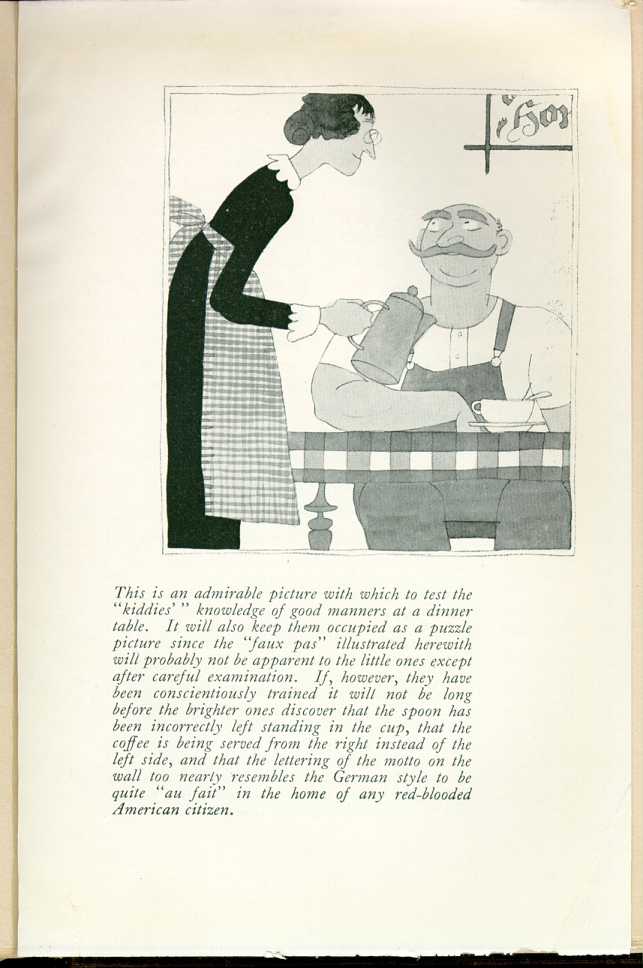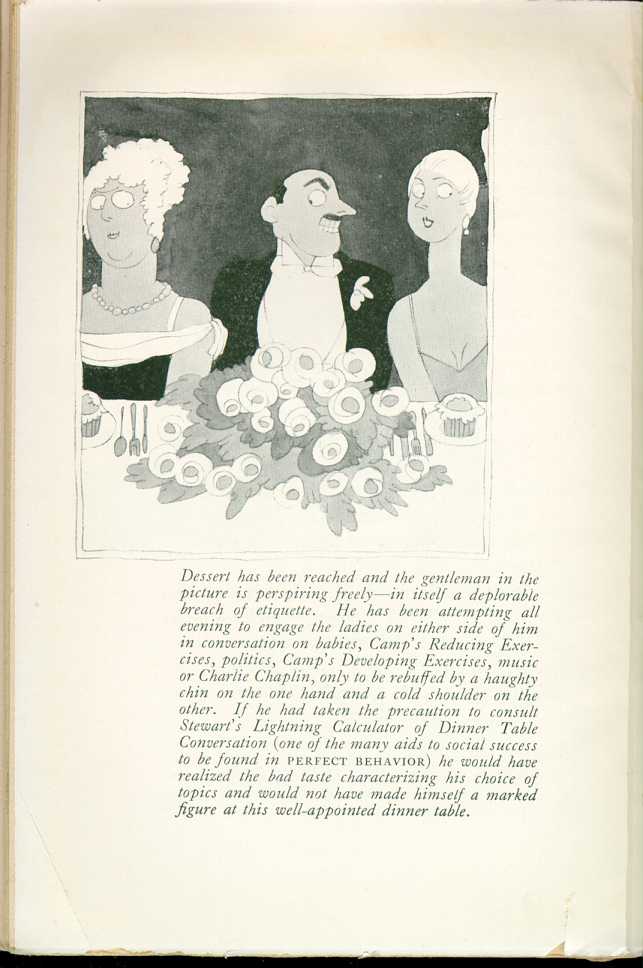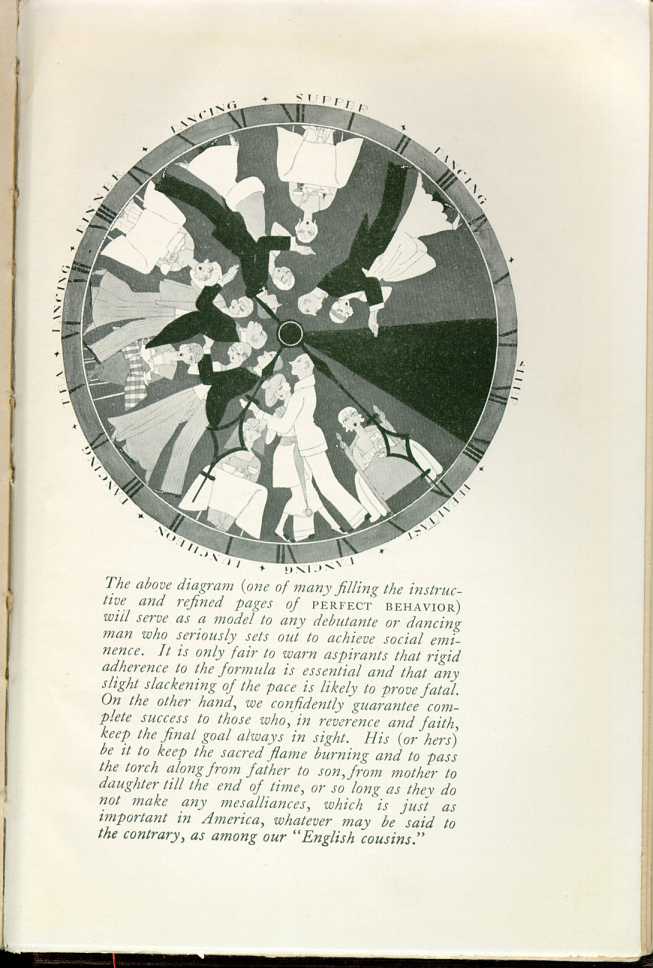|
CHAPTER NINE: THE ETIQUETTE OF DINNERS AND BALLS
Perfect Behavior | ||
9. CHAPTER NINE: THE ETIQUETTE OF DINNERS AND BALLS
FORMAL DINNERS IN AMERICA
EATING is an extremely old custom and has been practiced by the better classes of society almost without interruption from earliest times. And "society," like the potentate of the parable whose touch transformed every object into gold, has embellished and adorned the all-too-common habit of eating, until there has been evolved throughout the ages that most charming and exquisite product of human culture—the formal dinner party. The gentleman of today who delightedly dons his dress suit and escorts into a ten-course dinner some lady mountain climber or other celebrity, is probably little aware of what he owes to his forefathers for having so painstakingly devised for him such a pleasant method of spending his time.
But "before one runs, one must learn to
TABLE MANNERS FOR CHILDREN
AS a matter of fact, it is never too early to begin to acquire the technique of correct eating, and the nursery is the best possible place for the first lessons in dining-room behavior. Children should be taught at an early age the fundamentals of "table" manners in such a way that by the time they have reached the years of manhood the correct use of knife, fork, spoon and fingerbowl is to them almost

This is an admirable picture with which to test the "kiddies'" knowledge of good manners at a dinner table. It will also keep them occupied as a puzzle picture since the "faux pas" illustrated herewith will probably not be apparent to the little ones except after careful examination. If, however, they have been conscientiously trained it will not be long, before the brighter ones discover that the spoon has been incorrectly left standing in the cup, that the coffee is being served from the right instead of the left side, and that the lettering of the motto on the wall too nearly resembles the German style to be quite "au fait" in the home of any red-blooded American citizen.
[Description: Drawing of a woman standing over a seated man with a coffee pot in her hand. ]
Dessert has been reached and the gentleman in the picture is perspiring freely—in itself a deplorable breach of etiquette. He has been attempting all evening to engage the ladies on either side of him in conversation on babies, Camp's Reducing Exercises, politics, Camp's Developing Exercises, music or Charlie Chaplin, only to be rebuffed by a haughty chin on the one hand and a cold shoulder on the other. If he had taken the precaution to consult Stewart's Lightning Calculator of Dinner Table Conversation (one of the many aids to social success to be found in PERFECT BEHAVIOR) he would have realized the bad taste characterizing his choice of topics and would not have made himself a marked figure at this well-appointed dinner table.
[Description: Drawing of a man with clenched teeth seated in between two women at a dinner table. ]Thus, for example, if you are a father and your boy Edward persists in bringing his pet tadpole to the table in a glass jar, you should not punish or scold him; a much more effective and graphic method of correcting this habit would be for you to suddenly pick up the tadpole one day at luncheon and swallow it. No whipping or scolding would so impress upon the growing boy the importance of the fact that the dinner table is not the place for pets.
Another effective way of teaching table manners to children consists in making up attractive games about the various lessons to be learned. Thus, whenever you have guests for dinner, the children can play "Boner" which
- If the guest has dirty hands, 5 points.
- If the guest uses wrong fork or spoon, 5 points.
- If the guest chokes on bone, 8 points.
- If the guest blows on soup, 5 points.
- If the guest drops fork or spoon, 3 points.
- If the guest spills soup on table, 10 points.
- If the guest spills soup on self, 1 point.
Of course it is often well to tell the guests about the game in advance in order that they may not feel embarrassed but will enter thoroughly into the spirit of this helpful sport.
A CHILD'S GARDEN OF ETIQUETTE
CHILDREN can also acquire knowledge more easily if it is imparted to them in the form of verse or easy rhymes, and many
To be a nice hors d'œuvre
And just bring joy to people
Whom fondest you were of.
But not to any haunting tune.
In zones both temp. and torrid,
And when they are good they are very good indeed,
And when they are bad they are horrid.
With gin so rare and old,
And two of them will set you right
But four will knock you cold.
Because she's eaten too much garlic.
Mama said the other day,
"A little goes a long, long way."
And said, "Those dams are not for me."
From eating shad au gratin
Aunt Ethel said it served him right
And went back to her flat in
NEWARK (spoken)
Poor Uncle Frank! (chanted)
So full of late filet of sole.
Remarked, "That apple looks quite tasty.
Now George a dentist's bill must pay
Because he was so very hasty.
The proverb's teachings we must hold
"All that glitters is not gold."
And mama said to George, "Oh, shoot,
You've gone and ruined my glass fruit."
Jim knocked Mrs. Vanderbilt for a loop.
Kate drank from her finger bowl,
Kate knocked Mrs. Vanderbilt for a goal.
Children who perform such tricks
Are socially in Class G-6.
ETIQUETTE IN THE SCHOOL
OF course, as the children become older, the instruction should gradually come to embrace all forms of correct behaviour, and the youthful games and rhymes should give way to the more complex and intricate problems
A Problem in Mathematics (7th grade)
A swimmer starts across a stream which is 450 yards wide. He swims
for five minutes at the rate of three miles per hour, and for three
minutes at the rate of four miles per hour. He then reaches the other
bank, where he sees a young lady five feet ten inches tall, walking
around a tree, in a circle the circumference of which is forty-two
yards.
A. What is the diameter of the circle?
B. How fast is the current flowing in the stream?
C. At what point would the swimmer land if there were no current in the
stream?
E. But suppose that he has no bathing suit on?
And so, when the young person has reached the age for his first formal dinner party, he will undoubtedly be able to handle the fundamentals of correct etiquette in a satisfactory manner. But, as in every sport or profession, there are certain refinements—certain niceties which come only after long experience—and it is with a view of helping the ambitious diner-out to master these more complex details, that I suggest that he study carefully the following "unwritten laws" which govern every dinner party.
In the first place, a guest is supposed tacitly to consent to the menu which the hostess has arranged, and the diner-out who makes a habit of saying "Squab, you know, never agrees with me—I wonder if I might have a couple of poached eggs," is apt to find that
Practical jokes are never countenanced at a formal affair of this sort. I do not mean that a certain amount of good-natured fun is out of place, but such "stunts" as pulling the hostess' chair out from under her—or gleefully kicking the shins of your neighbor under the table and shouting "Guess who?"—are decidedly among the "non-ests" of correct modern dinner-table behaviour.
Then, too, it is now distinctly bad form to practise legerdemain or feats of sleight-of-hand at a dinner party. Time was when it was considered correct for a young man who could do card or other tricks to add to the gayety of the party by displaying his skill, but that time is past, and the guest of today, who thinks to make a "hit" by pulling a live rabbit or a potted plant from the back of the mystified hostess or one of the butlers, is in reality only making a "fool" of himself if he only knew it. The same "taboo" also holds good as concerns
It does not "do," either, to "ride your hobby" at a dinner party, and the real truth as to the cause of the sudden social ostracism of young Freddie H—, a New York clubman of some years ago (now happily deceased), is that on one occasion this young fellow, who had developed a craze for marksmanship amounting almost to a mania, very nearly
It might also be remarked that the possession of certain physical gifts—such as the ability to wriggle one's ears or do the "splits"—is in itself no "open sesame" to lasting social success. "Slow and sure" is a good rule for the young man to follow, and although he may somewhat enviously watch his more brilliant colleagues as they gain momentary applause by their ability to throw their thumbs out of joint or squirt water through a hole in their front teeth, yet he may console himself with the thought that "the race is not always to the swift" and that "Rome was not built in a day." The gifts of this world have been distributed fairly equally, and you may be sure that the young girl who has been born a ventriloquist very likely is totally unable to spell difficult words correctly or carry even a simple tune.
CONVERSATION AT DINNER
GRADUALLY, however, conversation—real conversation—is coming into its own as the favorite pastime of dinner guests, and the young man or lady who can keep the conversational "ball" rolling is coming more and more into demand. Good conversationalists are, I fear, born and not made—but by study and practise any ambitious young man can probably acquire the technique, and, with time, mould himself into the kind of person upon whom hostesses depend for the success of their party. As an aid in this direction I have prepared the following chart which I would advise all my readers to cut out and paste in some convenient place so that at their next dinner party it can be readily consulted.
STEWART'S LIGHTNING CALCULATOR OF DINNER TABLE CONVERSATION
THIS chart divides the dinner into its various courses, and under each course is given what I call an "opening sentence," together with your partner's probable reply and the topic which is then introduced for discussion. And, most valuable of all, under each such topic I have listed certain helpful facts which will enable you to prolong the conversation along those lines until the arrival of the next course, and the consequent opening of another field for discussion. The chart follows:
- I. Cocktails.
You say to the partner on your right: "What terrible gin!" She (he) replies: "Perfectly ghastly." This leads to a discussion of: Some Aspects of Alcohol.
- 1. An oyster soaked in alcohol becomes
quite rigid in eleven minutes.
218
- 2. Senator Volstead was born Sept. 4, 1869.
- 3. Alcohol, if taken in too great quantities, often produces internal disorders.
Helpful Facts:
- 1. An oyster soaked in alcohol becomes
quite rigid in eleven minutes.
- II. Oysters.
You say to the partner on your right: "Think of being an oyster!"
She (he) replies: "How perfectly ghastly."
This leads to a discussion of: Home Life of Oysters.
- 1. The average life of an oyster is 38 days, 11 hours.
- 2. Polygamy is practised among certain classes of oysters.
- 3. The first oyster was eaten by Ossip Gatch, a Pole (d. 1783).
Helpful Facts:
- III. Fish.
You say to the partner at your right: "Do you enjoy fish?"
She (he) replies: "I simply adore fish."
This leads to a discussion of: Fish—Then, and Now.219
- 1. Fish make notoriously bad pets, whereas seals can be taught to do many novel tricks.
- 2. Gloucester (Mass.) smells badly in summer.
- 3. Gloucester (Mass.) smells badly in winter.
Helpful Facts:
- IV. Meat.
You say to the partner at your right: "Have you ever been through the StockYards?"
She (he) replies: "No." ("Yes.")
This leads to a discussion of: "The Meat Industry in America."
- 1. Every time a street car goes over the Brooklyn Bridge, a steer is killed in Chicago—and oftener.
- 2. Raw beefsteak in quantities is
harmful to children under two
years of age.
220
- 3. A man died recently in Topeka, Kansas, weighing 312 pounds.
- 4. Many prominent people live on the North Side of Chicago.
Helpful Facts:
- V. Salad.
You say to the partner at your right: "What is your favorite salad?"
She (he) replies: "I don't know, what's yours?"
This leads to a discussion of: Favorite Things.
- 1. Richard Barthelmess is married.
- 2. B. V. D. stands for "Best Value Delivered."
- 3. Amy Lowell is fond of cigars.
Helpful Facts:
- VI. Dessert.
You say to the partner at your right: "I love ice cream."
She (he) replies: "So do I."
This leads to a discussion of: Love.
- 1. New York is the hardest state in which to get a divorce in America.
- 2. Dr. Sigmund Freud is now living in Vienna, Austria.
- 3. D. H. Lawrence has a black beard.
Helpful Facts:
221
BALLS AND DANCES
IN order to succeed in the modern ballroom, and especially in the ballrooms of our exclusive country clubs, a young gentleman or lady of fashion must today be possessed of the following two requisites: i. A "Line." 2. A closed car. The latter of these "sine qua nons" is now owned as a matter of course by most families and is no longer regarded as a mark of distinction. The former requisite, however, is not so common, but it is nevertheless true that any young person with ambition and a good memory can eventually acquire a quite effective "Line." It is a great aid in this direction if one happens to have spent a year or more at one of our leading eastern universities or "finishing schools." These vary, of
"Lines" vary also in accordance with the different types of girls who happen to be using them, and (to misquote a rather vulgar proverb) "What is one girl's food may be another girl's poison." Thus it happens that the "Line" which is most universally and interminably employed by the "beautiful" type of girl (consisting, in its entirety, of the three words "How perfectly priceless") would never in the world do for the young miss whose chief asset is a kind heart or a love for really good books.
MIXED DANCING
ANOTHER quality which is often helpful on the dance floor, especially to girls, is the ability to dance. This seems to have become

The above diagram (one of man), filling the instructive and refined pages of PERFECT BEHAVIOR) will serve as a model to any debutante or dancing man who seriously sets out to achieve social eminence. It is only fair to warn aspirants that rigid adherence to the formula is essential and that any slight slackening of the pace is likely to prove fatal. On the other hand, we confidently guarantee complete success to those who, in reverence and faith, keep the final goal always in sight. His (or hers) be it to keep the sacred flame burning and to pass the torch along from father to son, from mother to daughter till the end of time, or so long as they do not make any mesalliances, which is just as important in America, whatever may be said to the contrary, as among our "English cousins."
[Description: Drawing of an illustrated clock. ]But in addition to all these necessary qualifications the really great person—the true super man or woman of the ballroom—must be possessed of that certain divine something, that je ne sais quoi ability to rise superior to all occasions, to overcome the most difficult situations, which has distinguished the great men and women of all ages. Joan of Arc had it, George Washington had it, Napoleon had it—and I venture to say that any of these three, had they lived today, Would have been a social success. But perhaps this fact can best be illustrated by taking a typical instance in the ballroom in which "When duty whispered
HINTS FOR STAGS
LET us suppose, for example, that you are a young man who has been invited to a dance to be given at the East Shore Country Club. It is your original intention, let us say, to attend as a "stag," but on the afternoon of the party you receive a note from a young lady of your acquaintance asking if you would be so kind as to accompany to the ball a guest of hers, a "sweet girl from South Orange" who was in her class at college.
The correct costume for a dance of this sort is usually a dinner coat with a black or white vest, and when you have robed yourself correctly, you should drive in your car to the young lady's home. There you are presented to the sweet girl from South Orange, who is six feet tall and has protruding teeth. After the customary words of greeting and a few brief bits of pleasantry, you set off with your partner for the dance.
Arrived at the East Shore Club, you find the party in "full swing," and after shaking hands with your host and hostess, you should ask your partner if she would care to dance.
The first three times that she steps on your left foot, you should politely murmur, "My fault." But when she begins to sing in your ear it is proper to steer her over toward the "stag line" in order to petition for an injunction or a temporary restraining order.
The "stag line" consists of a group of the wisest, shrewdest and most hard-hearted young men ever gathered together under one roof. The original purpose of a "stag line" was to provide a place where unattached young men might stand while searching for a partner, but the institution has now come to be a form of Supreme Court, passing life or death sentence upon the various débutantes who pass before it.
After you have piloted your partner five times along the length of this line you have a pretty fair idea as to her merits or demerits, and, in this particular case, you have a pretty
Instead of going directly to the punch bowl, you should turn your steps toward the "stag line." There you will find several young men whom only as late as that afternoon you counted among your very best friends, but who do not, at the present, seem to remember ever having met you before. Seizing the arm of one of these you say, "Tom, I want you to meet—" That is as far as you will get, for Tom will suddenly interrupt you by remarking, "Excuse me a minute, Ed—, I see a girl over there I've simply got to speak to. I'll come right back."
He will not come right back. He will not come back at all. And after you have met with the same response from four other so-called friends, you should return to the South Orange visitor and "carry on."
At the end of the second hour, however, your mind should begin to clear, and if you
"I know a lovely walk," you should say, "across a quaint old bridge."
The rest is, of course, easy. Arrived in the middle of the quaint old bridge, which leads across a cavern some three hundred feet deep, you should quickly seize the tall college graduate, and push her, not too roughly or ungentlemanly, off the bridge.
And, if you are really a genius, and not merely "one of the crowd" you will return to the ballroom and, going up to the young lady who was responsible for your having met the sweet girl from South Orange, you will offer her your arm, and smile invitingly.
"I know a lovely walk," you will say, "across a quaint old bridge."
 [Description:
Drawing of a man sitting at a dinner table, leaning to one side. An
older woman sits on one side of him; another woman stands at his other
side with her hands clasped together.
]
[Description:
Drawing of a man sitting at a dinner table, leaning to one side. An
older woman sits on one side of him; another woman stands at his other
side with her hands clasped together.
]
|
CHAPTER NINE: THE ETIQUETTE OF DINNERS AND BALLS
Perfect Behavior | ||